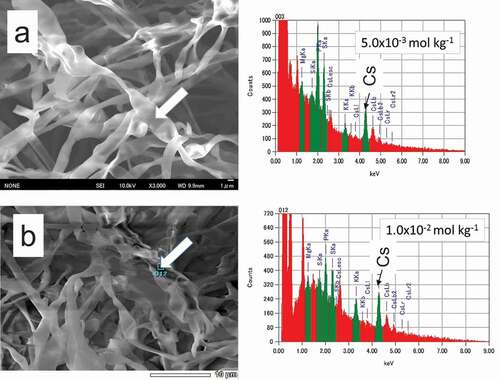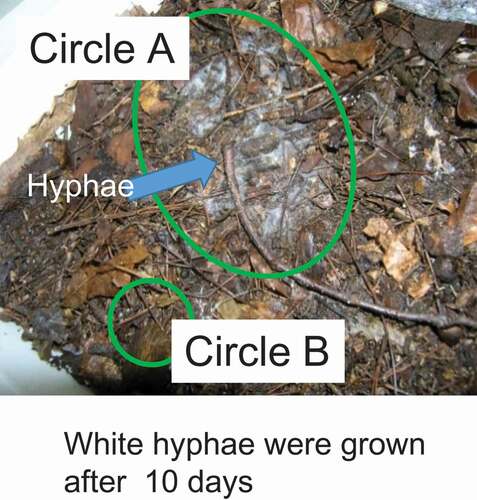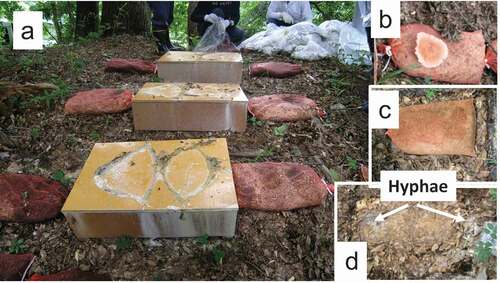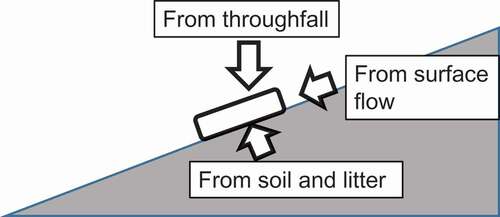 ?Mathematical formulae have been encoded as MathML and are displayed in this HTML version using MathJax in order to improve their display. Uncheck the box to turn MathJax off. This feature requires Javascript. Click on a formula to zoom.
?Mathematical formulae have been encoded as MathML and are displayed in this HTML version using MathJax in order to improve their display. Uncheck the box to turn MathJax off. This feature requires Javascript. Click on a formula to zoom.ABSTRACT
We used the spent mushroom substrata (SMSs) which are a kind of by-product after growing edible mushrooms for the in-situ investigation of radioactive Cs mobility in litter zone in a forest of Fukushima prefecture, Japan. The powder SMS was filled in a plastic net bag of 0.35 × 0.55 m, then was placed in a forest for ~6 months under three kinds of different conditions without treatment (No treatment), covered with wooden box (With box), and with zeolite placed on upper position of ground surface (With zeolite). We determined the ratio of radioactivity (TF) in the SMS to that of the soil and litter beneath the SMS bags. TFs of ‘No treatment’ and of ‘With zeolite’ were determined between ~0.01 and ~0.05 for 6 months. On the other hand, TFs of ‘With box’ were lower by one order at 2 and 4 months than those of ‘No treatment’ and of ‘With zeolite,’ and nearly the same values as TFs of ‘No treatment’ and ‘With zeolite’ at 6 months. These results clearly indicate that radioactive Cs accumulates in SMS mainly by throughfall. In addition, for a period of several months, fungi contribute to the accumulation of radioactive Cs in the litter zone, even though radioactive Cs was tightly associated with the soil.
1. Introduction
The nuclear accident at the Fukushima Daiichi Nuclear Power Plant (FDNPP) occurred as a consequence of the massive earthquake and associated tsunami that struck the Tohoku and north Kanto regions of Japan on 11 March 2011. A series of hydrogen explosions occurred from 13 to 15 March at the units 1 and 3. The release rate of 137Cs on 15 March is estimated between 1012 and 1015 Bq/h [Citation1]. This fallout radioactive Cs was dispersed from FDNPP to ocean [Citation1,Citation2] and land [Citation1,Citation3]. The released radioactive Cs was deposited not only on the ground of Fukushima prefecture area where FDNPP is located [Citation4], but also on the neighboring prefectures [Citation5]. The spatial concentration distribution and depth profiles of radioactive Cs were measured [Citation6–Citation8] to estimate dose rate and to estimate the fate in the terrestrial environment.
When radioactive Cs was deposited on soil ground, radioactive Cs was remained up to 5 cm from the ground surface. Cesium at low concentration is strongly sorbed on mica-like minerals [Citation9–Citation12]. These results suggest that some amounts of radioactive Cs are tightly associated with soils.
About 70% of land area in Fukushima prefecture is covered by forest. This forest is composed of trees with stems, leaves, and roots, litters with fallen leaves and branches, and soils. In the litter layer, 137Cs had largely migrated to surface soil, and approximately 80% of the 137Cs in forest soils remained within litter layer to 5 cm soil layer [Citation8]. In addition, radioactive Cs deposited on the canopy of trees may fall to the litter [Citation13] and flow on the ground surface. Thus, migration of radioactive Cs in the contaminated forest should be considered to combine the transport not only in soil, but also via throughfall and surface flow [Citation14,Citation15].
After the Chernobyl accident, the effect of microorganisms on the migration of radioactive Cs, especially in long-term migration, has been studied [Citation16,Citation17]. specific microorganisms were reported to accumulate highly radioactive Cs [Citation2,Citation18]. Stemmer et al. [Citation19] reported that approximately 1.2‒2.7% of the total radioactive Cs soil inventory was accumulated in fungal microbes. Many kinds of fruiting bodies of fungi accumulate radioactive Cs [Citation20]. Fungus Saccharomyces cerevisiae accumulates radioactive Cs from agar medium in the presence of many kinds of minerals [Citation21]. Fungus accumulates radioactive Cs during decomposition of litter in forest after FDNPP accident [Citation22]. These results indicate that fungal microorganisms accumulate radioactive Cs in the contaminated forest.
Spent mushroom substrata (SMSs) are a by-product of edible mushroom production, which contains high contents of bacterial protein, various metabolites, and underutilized nutrients, has been reported to be very good organic manure and soil conditioner [Citation23]. SMS is used for immobilization of Cd in the contaminated soil [Citation24]. These studies have proven to be an effective biosorbent for removing cadmium, chromium, and lead in a solution with pH 4.8–7.0 [Citation25]. SMS is also effective to remediate the contaminated soil by Polycyclic aromatic hydrocarbons [Citation26] and pesticide [Citation27,Citation28].
The metabolites in the SMS can grow some microorganisms involving filamentous fungi in the spent mushroom bed. Fungi are known to accumulate radioactive Cs as described above. These facts suggest that SMS can apply to an in-situ investigation of migration behavior of radioactive Cs in litter zone in the contaminated forest.
In this study, we packed SMS in a plastic mesh bag and placed on the litter under three kinds of different conditions without treatment, covered with wood box, and blocked surface water flow by zeolite placed on upper position. These treatments restrict directions of the radioactive Cs transport via surface flow or throughfall. We demonstrated accumulation of radioactive Cs to the SMS. We discuss the migration behavior of radioactive Cs from the viewpoints of flow directions of radioactive Cs to be accumulated in the SMS.
2. Experimental site and methods
2.1. Site
The forest located in Nihonmatsu-city, Fukushima, was used as experimental site. The dose rate at 1 m height from ground surface was averaged to be 0.53 μSv/h. The activity of 137Cs in the litter zone involving litter and surface soil of ~4 cm was detected between 1 × 103 and 5 × 104 Bq/kg.
2.2. Accumulation of cesium by hyphae of filamentous fungi
In the accumulation experiments, pre-cultured hyphae of shiitake mushroom were inoculated on a membrane filter with a pore size of 0.2 μm placed on the 10 g potato dextrose (PD) agar media involving 4 g potato infusion from 200 g/L potatoes and 40 g/L dextrose. The agar medium contained either 5 × 10−3 or 1.0 × 10−2 mol kg−1 of CsCl. A schematic figure of the agar media used for the agar media experiments is shown in Fig. S1. The hyphae were exposed to agar medium containing CsCl for ~1 week at 20°C. Accumulation of Cs in the hyphae was detected by secondary electron microscopy (SEM) (JEOL; JSM-7000F) analysis with energy dispersive spectra analysis.
2.3. Accumulation of radioactive cesium by hyphae grown mushroom substrate from the contaminated fallen leaves
The contaminated fallen leaves and the contaminated soil were collected in the forest of Towa district in Nihonmatsu city in Fukushima, Japan, in May 2012, and in the site of Japan Atomic Energy Agency, Tokai, Ibaraki, Japan, in May 2012, respectively. The schematic diagram of the fallen leaves layer is shown in Fig. S2 (left). The contaminated soil was placed in depth of ~5 cm in stainless tray of 30 cm × 50 cm. On the contaminated soil, two pieces of the half circle of hyphae grown mushroom substrates of 25 cm in diameter × 5 cm thickness were installed (Fig. S2 (right bottom)). The hyphae-grown substrates and the contaminated soil were covered with the contaminated fallen leaves of ~10 cm in depth (Fig. S2 (right upper)). The contaminated soil and the fallen leaves were mixed well before using in the experiments. Two samples were prepared for the experiments.
The soil and the leaves were dried in room condition, and then the radioactivity of 137Cs was measured after weighing. The radioactivity of 137Cs in the contaminated soil and the fallen leaves were 1.5 × 104 Bq/kg and 4.7 × 104 Bq/kg, respectively.
2.4. Demonstration test of radioactive Cs accumulation in spent mushroom substrate
We used the SMS, which is a kind of by-product after growing edible mushrooms, for the in-situ investigation for migration of radioactive Cs in Fukushima. In the present study, an edible mushroom of SMS was used. The SMS was filled in the plastic mesh bag of 0.35 × 0.55 m to be about 5 kg. The thickness of the SMS bag was approximately 0.05 m.
The SMS bags were placed in a forest for approximately 2, 4, and 6 months. The SMS bags were placed on the litter under three kinds of different conditions without treatment, covered with wood box, and blocked surface water flow by zeolite placed on upper position (Photo. S2a). Triplicate samples of each condition for three durations were tested. Distance between upper and lower SMS was ~40 cm. The plastic mesh bags with SMS were dangled from tree in forest to accumulate radioactive Cs in throughfall.
To test the accumulation of radioactive Cs to SMS from litter zone, SMS bags were placed on the litter, placed on litter after half of the litter was removed (litter was removed approximately 5 cm thickness), and placed on ground after all of the litter was removed. In the latest test, the SMS bag was placed directly on the forest soil. After 2 months, the SMS bags were removed for the measurement. .
After 2, 4, and 6 months, the SMS bags were removed from the litter, and some portion of the substrate was dried in air, and then provided to measure radioactivity. The radioactivity of 137Cs of the soil and litter beneath the SMS bags was measured for determining the ratio (TF) of 137Cs in the SMS to that of soil.
We measured the depth profile of activity of 137Cs in the soil in the forest, showing more than 90% of total 137Cs was present up to 4 cm in depth. The soil up to 4 cm in depth was collected.
The radioactivities of 137Cs in the SMS and in the soils were measured by γ-spectrometer (ORTEC, Oak Ridge, TN, USA) [Citation10].
3. Results and discussion
3.1. Accumulation of cesium by hyphae of filamentous fungi
shows SEM photographs and EDS spectra of the hyphae of filamentous fungus cultured in PD agar medium with 5.0 × 10−3 () and 1.0 × 10−2 () mol kg−1 CsCl, respectively. The SEM photographs show hyphae grown in agar medium with 5.0 × 10−3 and 1.0 × 10−2 mol kg−1 CsCl. When Cs was contained in the agar medium, the EDS spectrum showed that the peaks of Lα and Lβ of Cs were distinguished in the spectrum. In the EDS spectrum, the peaks of Mg, Si, P, S, and K were also distinguished, indicating that these elements were involved in the hyphae. Quasi-quantitative elemental analysis of EDS spectrum shows that atom% of Cs accumulated in hyphae from the agar containing 5.0 × 10−3 and 1.0 × 10−2 mol kg−1 CsCl were 26% and 35%, respectively. This result indicates that the fungi accumulate Cs in the hyphae from the agar medium, and higher amount of Cs was accumulated form the agar containing higher concentration of Cs.
3.2. Accumulation of radioactive cesium by hyphae grown mushroom substrate from the contaminated fallen leaves
The photograph of the fallen leaves formed as shown Fig. S2 after 10 days () showed that the color of central part of the fallen leaves was changed to white, indicating that hyphae were developed in the fallen leaves within 10 days. At 35 days, the white part was developed to the edge of the fallen leaves. The fallen leaves with white color (Photo 1: Circle A; hereafter called FL A) and those with white color of less intensity (Photo 1: Circle B; hereafter called FL B) were sampled. Difference of intensity in white color indicates different amounts of hyphae.
. Photograph of SMS inoculated for 10 days in the contaminated soil and litter leaves layers. Color of the fallen leaves was partially changed to white as shown by Circle A. The dark brown color area showed hyphae are not well developed (Circle B).
The average radioactivities of 137Cs of FL A and FL B in the two samples were 8.4 × 104 ±9.2×103 Bq/kg and 5.6 × 104 ±6.0×103 Bq/kg, respectively, showing higher radioactivity in FL A than FL B. These results indicate that higher activity of 137Cs is likely to be accumulated in the higher hyphae grown. Thus, radioactive Cs was accumulated in the hyphae grown in the fallen leaves.
3.3. Radioactive Cs accumulated in SMS
After 2 months, SMSs were collected (). From some of the SMS, fruit body of mushroom was developed, indicating that hyphae would be grown in SMS (Photo. 2b). After removal of covered box, beneath and around SMS hyphae were recognized (Photo. 2c, 2d), indicating that hyphae of some kinds of fungi were developed around SMS within 2 months. Radioactivity of the SMS and soils collected after 2 months is shown in . The activity of 137Cs in soil samples was distributed between 9.3 × 103 Bq/kg and 1.6 × 104 Bq/kg, indicating that radioactive Cs was unevenly deposited in the forest ground. Average radioactivities of 137Cs in the SMS were 250, 64, and 180 Bq/kg, for ‘No treatment,’ ‘With box,’ and ‘With zeolite,’ respectively. Interestingly, the radioactivity of 137Cs in the SMS of ‘No treatment’ at the lowest position was higher by 1.8, 1.1, and 0.8 times than that of the uppermost position at 2, 4, and 6 months, respectively. This indicates that ~40 cm is a sufficient distance for the SMS placed to keep independent accumulation of radioactive Cs in the experimental site.
. Photograph of SMS bags after 2 months placement on the litter in the forest. b: fruit body was developed from SMS, indicating growth of hyphae in SMS, c: after cover was removed from ‘With box’ sample, and d: after removing SMS. Hyphae shown by arrows were grown below SMS, indicating hyphae of filamentous fungi were developed outside SMS.
Figure 2. Average radioactivity of 137Cs of SMS and soil placed on the litter under three kinds of different conditions without treatment (No treatment), covered with wood box (With box), and blocked surface water flow by zeolite placed on upper position (With zeolite). Error bar shows standard deviation. Activity of 137Cs in soil and SMS samples are referred by arrows. Bar showed deviation of the activity. Triplicate samples were measured for each condition.

Time courses of TF of radioactive Cs from litter and soil to the SMS for 6 months are shown in . After 2 months, TF of ‘No treatment’ was the highest among the conditions. The lowest TF was determined for ‘With box,’ indicating that SMS accumulated radioactive Cs not only from litter and soil beneath the SMS, but also from other directions. TF of ‘No treatment’ was higher than that of ‘With zeolite,’ indicating that some portion of radioactive Cs was transported on the surface from upper position of the SMS (surface flow). TF of ‘With zeolite’ was higher than that of ‘With box,’ indicating that radioactive Cs was transported from other direction from soil and litter beneath the SMS and from the surface flow.
Figure 3. TF of radioactive Cs accumulated in SMS for 2, 4, and 6 months under three kinds of different conditions without treatment (No treatment), covered with wood box (With box), and blocked surface water flow by zeolite placed on upper position (With zeolite). Error bar shows standard deviation of triplicate samples.
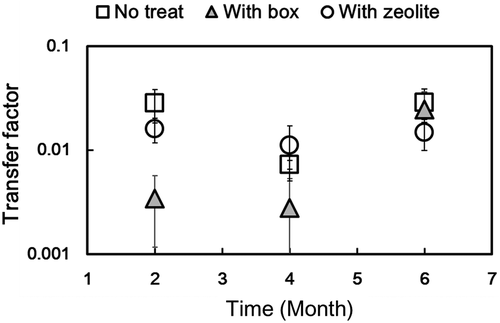
The radioactivity in SMS dangled from tree was 72 Bq/kg, indicating that some fraction of radioactive Cs was accumulated in the litter by throughfall. Annual amount of 137Cs deposited to ground from the trees by throughfall was ~100 Bq/m2 after Chernobyl accident [Citation29]. Thus, one of the possible pathways of the higher fraction of radioactive Cs in ‘No treatment’ and ‘With zeolite’ is from throughfall from canopy of tree.
TF of ‘No treatment’ and of ‘With zeolite’ fluctuated with time. The fluctuation of TF of ‘No treatment’ was coupled with TF of ‘With zeolite’ even though magnitude relationship at 2 and 6 months was different from that at 4 months. On the contrary, TFs of ‘With box’ were lower by one order at 2 and 4 months than those of ‘No treatment’ and of ‘With zeolite,’ and nearly the same values as TFs of ‘No treatment’ and ‘With zeolite’ at 6 months. This result indicates clearly that longer contact of SMS with the contaminated soil and litter accumulates higher amounts of radioactive Cs in SMS, even though radioactive Cs from throughfall and surface flow was interrupted.
These results indicate the presence of three pathways of radioactive Cs accumulated in the SMS (). Those pathways are from litter zone (involving soil and litter), from surface flow, and from throughfall. For ‘With box,’ radioactive Cs was only accumulated from the litter zone. For ‘With zeolite,’ radioactive Cs was accumulated from the litter zone and from throughfall. For ‘No treatment,’ radioactive Cs was accumulated from all of the three pathways.
TF of SMS bags placed for 2 months on the litter, placed on the litter after half of the litter was removed, and placed on the ground after all of the litter was removed is shown in . TF was nearly the same among the three conditions, indicating that similar amount of radioactive Cs was accumulated in SMS even all of litter was removed. This result indicates that origin of radioactive Cs from litter or soil is not separated each other. The litter zone contains the soil-sorbed radioactive Cs from the surface flow and throughfall. This is one reason not to identify the origin. The other reason is that the fraction of radioactive Cs from the litter zone is lower by one order than from surface flow and throughfall.
3.4. Migration behavior of radioactive Cs around litter zone
In the forest, more than 60% of the total deposited radioactive Cs remained in the canopy after 5 months of the initial fallout [Citation13]. During 2011–2013, radioactive Cs was deposited from the canopy to the litter zone via throughfall, stemflow, and litterfall processes [Citation13,Citation30,Citation31]. Our results showed that radioactive Cs was accumulated in SMS placed on litter zone for 6 months. Amounts of radioactive Cs accumulated depended on the three kinds of different conditions of SMS – those are ‘No treatment,’ ‘With box,’ and ‘With zeolite.’ These results showed that radioactive Cs accumulated in SMS was originated by throughfall, surface flow, and litter zone ().
For 2 months, the amounts of radioactive Cs accumulated were in the order of:
Throughfall > Surface flow > Litter zone.
It is reported that amount of accumulated radioactive Cs to the litter zone from the canopy was 4–50 times higher than the output from the litter zone during the summer monsoon in Fukushima [Citation32]. This result is in agreement with our result that highest accumulation of radioactive Cs in SMS was transported from the canopy via throughfall.
For 2 and 6 months, the amounts of radioactive Cs accumulated via throughfall was higher than that via surface flow, even though the order for 4 months was opposite. Sakai et al. [Citation33] showed that approximately 40% of radioactive Cs in the litter was dissolved into water after soaking for 30 days. They also suggested that the dissolved radioactive Cs is transferred to ecosystem. In the present study, some portion of radioactive Cs was transported from the surface flow to the SMS. Origin of radioactive Cs contained in the surface flow was divided into two ones. One is radioactive Cs in the litter zone of the upper position of the SMS, which is dissociated from the litter by rain water. The other is originated from radioactive Cs contained in throughfall, which was deposited on upper position and flew to the SMS.
For 2 and 4 months, amount of radioactive Cs transported from the soil was lower than those from throughfall and from the surface flow. It is well known that when radioactive Cs was deposited on soil ground, radioactive Cs was tightly associated with mica-like minerals [Citation11]. The tightly associated Cs may prevent the accumulation into SMS for ~4 months. The amount of radioactive Cs sorbed by minerals increased with increasing pH [Citation34]. Wang et al. [Citation24] showed that pH of the contaminated soil by Cd increased from ~6.5 to ~7.5 after treatment by SMS. Because Ca and Cs are cations, increase in pH in soil derived higher association of radioactive Cs with litter soil. Even though Cs is sorbed by SMS, small amount of radioactive Cs was accumulated from the litter zone for ~4 months.
For 6 months migration, TF of ‘With box’ increased indicating that radioactive Cs migrates from litterzone to SMS. Fungi in SMS are grown and lead out from SMS to litter (see Photos. 1 and 2). Because hyphae of fungi accumulate Cs from agar medium (), hyphae grown into the litter zone from SMS probably accumulate radioactive Cs for 6 months. The accumulated radioactive Cs is transported to hyphae grown in SMS. It is reported that accumulation of radioactive Cs in fungi from the contaminated litter took about 6 months [Citation22]. This result is in good agreement with our result. Thus, fungi probably contribute long-term migration of radioactive Cs in forest system.
These results clearly indicate that radioactive Cs accumulates in SMS mainly by throughfall. In addition, for a period of several months, fungi contribute to the accumulation of radioactive Cs in the litter zone, even though radioactive Cs was tightly associated with the soil.
4. Conclusion
In-situ accumulation of radioactive Cs into SMS from forest was studied for 6 months at Fukushima in Japan. The apparent transfer factors of radioactive Cs in SMS accumulated for 2 and 4 months were in the order of No treatment ≥ With zeolite > With box. Some amounts of radioactive Cs were accumulated in the SMS dangled from tree. These results indicate that SMS-accumulated radioactive Cs is originated from throughfall, surface flow, and litter zone. Among the three origins, throughfall transports the largest amounts of radioactive Cs to SMS. In addition, for 6 months or may be longer period, fungi in litter zone function important role for transport of radioactive Cs in forest.
Supplemental Material
Download Zip (974.7 KB)Acknowledgments
The authors thank to K. Shiina, K. Tanaka, and J. Namekawa for their help for the experiments and sampling of the SMS and soils.
Disclosure statement
No potential conflict of interest was reported by the authors.
Supplementary material
Supplemental data for this article can be accessed here.
Additional information
Funding
References
- Chino M, Nakayama H, Nagai H, et al. Preliminary estimation of release amounts of I-131 and Cs-137 accidentally discharged from the Fukushima Daiichi nuclear power plant into the atmosphere. J Nucl Sci Technol. 2011;48:1129–1134.
- Kawamura H, Kobayashi T, Furuno A, et al. Preliminary numerical experiments on oceanic dispersion of I-131 and Cs-137 discharged into the ocean because of the Fukushima Daiichi nuclear power plant disaster. J Nucl Sci Technol. 2011;48:1349–1356.
- Hidaka A, Yokoyama H. Examination of I-131 and Cs-137 releases during late phase of Fukushima Daiichi NPP accident by using I-131/Cs-137 ratio of source terms evaluated reversely by WSPEEDI code with environmental monitoring data. J Nucl Sci Technol. 2017;54:819–829.
- Komatsu M, Kaneko S, Ohashi S, et al. Characteristics of initial deposition and behavior of radiocesium in forest ecosystems of different locations and species affected by the Fukushima Daiichi nuclear power plant accident. J Environ Radioact. 2016;161:2–10.
- Jiang JY, Shimazoe K, Nakamura Y, et al. A prototype of aerial radiation monitoring system using an unmanned helicopter mounting a GAGG scintillator Compton camera. J Nucl Sci Technol. 2016;53:1067–1075.
- Kato H, Onda Y, Teramage M. Depth distribution of Cs-137, Cs-134, and I-131 in soil profile after Fukushima Daiichi nuclear power plant accident. J Environ Radioact. 2012;111:59–64.
- Tanaka K, Takahashi Y, Sakaguchi A, et al. Vertical profiles of iodine-131 and cesium-137 in soils in Fukushima prefecture related to the Fukushima Daiichi nuclear power station accident. Geochem J. 2012;46:73–76.
- Takada M, Yamada T, Takahara T, et al. Temporal changes in vertical distribution of Cs-137 in litter and soils in mixed deciduous forests in Fukushima, Japan. J Nucl Sci Technol. 2017;54:452–458.
- Sawhney BL. Potassium and cesium ion selectivity in relation to clay mineral structure. Clays Clay Miner. 1970;18:47.
- Kozai N, Ohnuki T, Arisaka M, et al. Chemical states of fallout radioactive Cs in the soils deposited at Fukushima Daiichi Nuclear Power Plant accident. J Nucl Sci Technol. 2012;49:473–478.
- Ohnuki T. Sorption characteristics of cesium on sandy soils and their components. Radiochim Acta. 1994;65:75–80.
- Ohnuki T, Kozai N. Sorption characteristics of radioactive cesium and strontium on smectite. Radiochim Acta. 1994;66–7:327–331.
- Kato H, Onda Y, Gomi T. Interception of the Fukushima reactor accident-derived Cs-137, Cs-134 and I-131 by coniferous forest canopies. Geophys Res Lett. 2012;39. DOI:https://doi.org/10.1029/2012GL052928.
- Kurihara M, Onda Y, Suzuki H, et al. Spatial and temporal variation in vertical migration of dissolved Cs-137 passed through the litter layer in Fukushima forests. J Environ Radioact. 2018;192:1–9.
- Takahashi J, Onda Y, Hihara D, et al. Six-year monitoring of the vertical distribution of radiocesium in three forest soils after the Fukushima Daiichi nuclear power plant accident. J Environ Radioact. 2018;192:172–180.
- Olsen RA, Joner E, Bakken LR. Soil fungi and the fate of radiocaesium in the soil ecosystem discussion of possible mechanisms involved in the radiocaesium accumulation in fungi and the role of fungi as a Cs-sink in the soil. London, UK: Elsevier Applied Science; 1990.
- Fawaris BH, Johanson KJ. Fractionation Of Cesium (Cs-137) In coniferous forest soil in central Sweden. SciTotal Environ. 1995;170:221–228.
- Tomioka N, Uchiyama H, Yagi O. Cesium accumulation and growth characteristics of Rhodococcus erythropolis CS98 and Rhodococcus sp. Strain CS402. Appl Environ Microbiol. 1994;60:2227–2231. Epub 1994/ 07/01.
- Stemmer M, Hromatka A, Lettner H, et al. Radiocesium storage in soil microbial biomass of undisturbed alpine meadow soils and its relation to (CS)-C-137 soil-plant transfer. J Environ Radioact. 2005;79:107–118.
- Yoshida S, Muramatsu Y, Ogawa M. Radiocesium concentrations in mushrooms collected in Japan. J Environ Radioact. 1994;22:141–154.
- Ohnuki T, Sakamoto F, Yamasaki S, et al. Effect of minerals on accumulation of Cs by fungus Saccaromyces cerevisiae. J Environ Radioact. 2015;144:127–133.
- Huang Y, Kaneko N, Nakamori T, et al. Radiocesium immobilization to leaf litter by fungi during first-year decomposition in a deciduous forest in Fukushima. J Environ Radioact. 2016;152:28–34.
- Marin-Benito JM, Andrades MS, Rodriguez-Cruz MS, et al. Changes in the sorption-desorption of fungicides over time in an amended sandy clay loam soil under laboratory conditions. J Soils Sediments. 2012;12:1111–1123.
- Wang FL, Ouyang W, Hao FH, et al. In situ remediation of cadmium-polluted soil reusing four by-products individually and in combination. J Soils Sediments. 2014;14:451–461.
- Chen GQ, Zeng GM, Tu X, et al. A novel biosorbent: characterization of the spent mushroom compost and its application for removal of heavy metals. J Environ Sci. 2005;17:756–760.
- Lau KL, Tsang YY, Chiu SW. Use of spent mushroom compost to bioremediate PAH-contaminated samples. Chemosphere. 2003;52:1539–1546.
- Rw R. Use of SMS as a compost matrix to degrade pesticide residuals. Compos Sci Utilization. 1994;2:56–62.
- Kuo WS, Regan RW. Aerobic carbamate bioremediation aided by compost residuals from the mushroom industry: laboratory studies. Compos Sci Utilization. 1998;6:19–29.
- Schimmack W, Forster H, Bunzl K, et al. Deposition of radiocesium to the soil by stemflow, throughfall and leaf-fall from beech trees. Radiat Environ Biophys. 1993;32:137–150. Epub 1993/ 01/01.
- Teramage MT, Onda Y, Kato H, et al. The role of litterfall in transferring Fukushima-derived radiocesium to a coniferous forest floor. SciTotal Environ. 2014;490:435–439.
- Loffredo N, Onda Y, Kawamori A, et al. Modeling of leachable Cs-137 in throughfall and stemflow for Japanese forest canopies after Fukushima Daiichi nuclear power plant accident. SciTotal Environ. 2014;493:701–707.
- Niizato T, Abe H, Mitachi K, et al. Input and output budgets of radiocesium concerning the forest floor in the mountain forest of Fukushima released from the TEPCO’s Fukushima Dai-ichi nuclear power plant accident. J Environ Radioact. 2016;161:11–21.
- Sakai M, Gomi T, Naito RS, et al. Radiocesium leaching from contaminated litter in forest streams. J Environ Radioact. 2015;144:15–20.
- Sasaki T, Terakado Y, Kobayashi T, et al. Analysis of sorption behavior of cesium ion on mineral components of granite. J Nucl Sci Technol. 2007;44:641–648.

